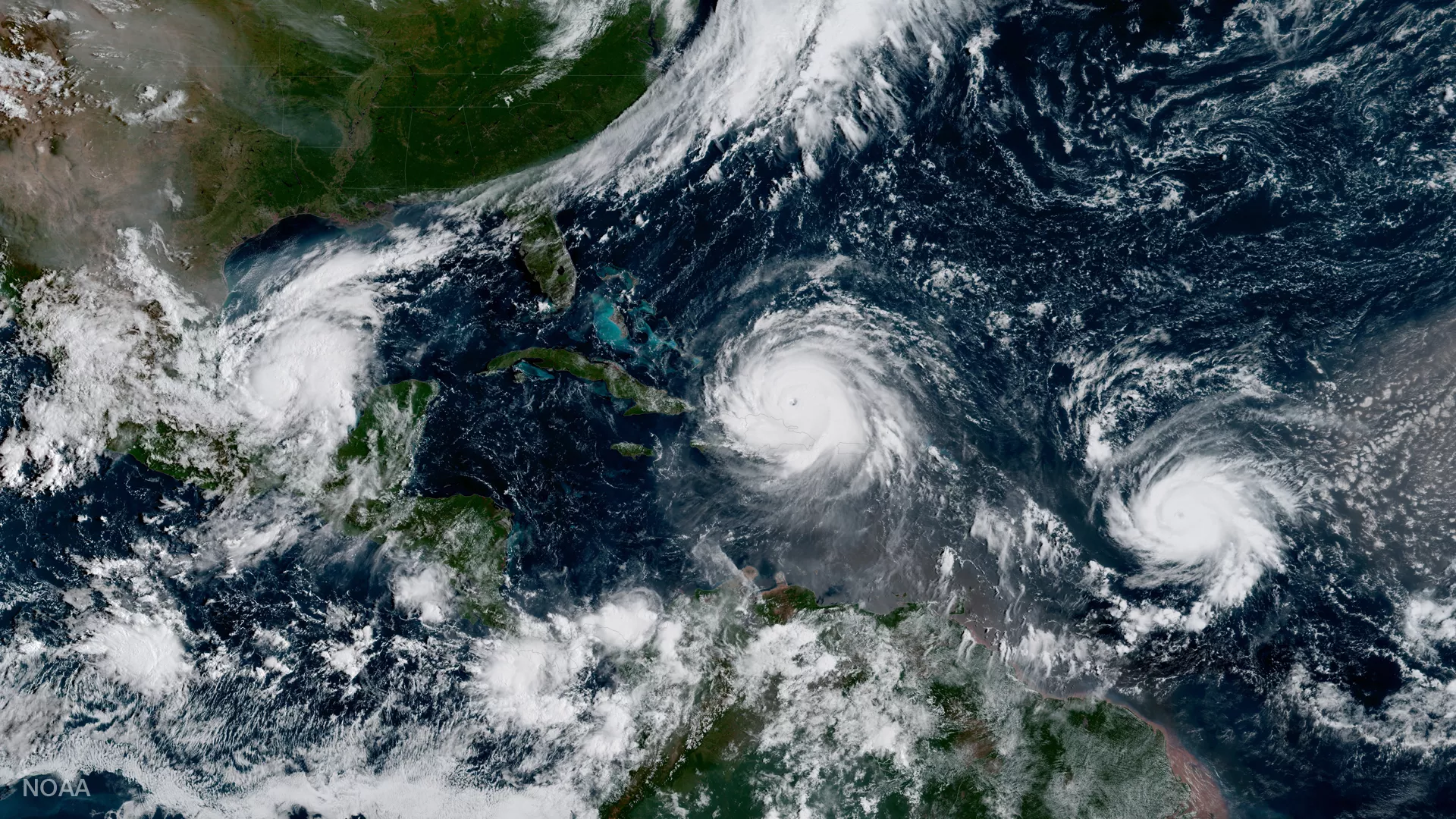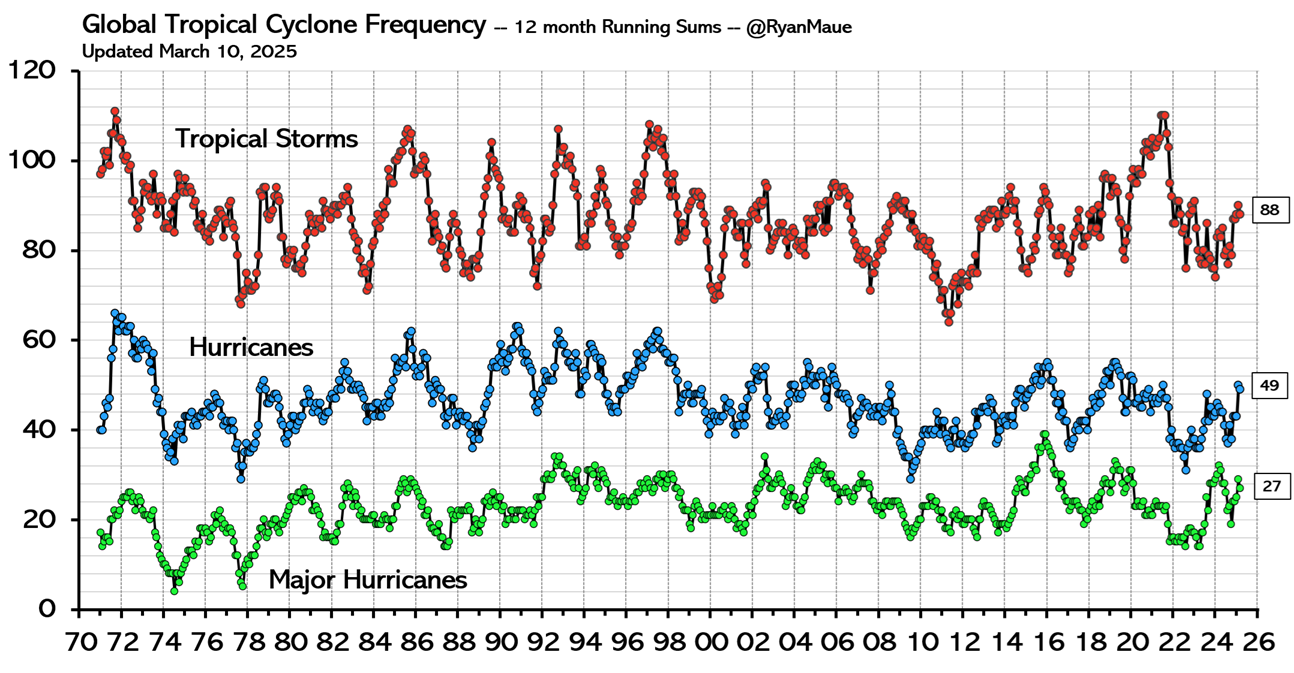This geocolor image from the GOES-16 satellite shows Hurricane Katia (L) Hurricane Irma (M) and Hurricane Jose (R) in the Atlantic Ocean on September 7, 2017. Image: NOAA
View this page as a printable (PDF) file: Climate at a Glance Hurricanes(2025)
Key Takeaways:
- There has been no increase in hurricanes as the planet has modestly warmed. In fact, data show hurricanes are trending slightly downward since 1971.
- Even the U.N. IPCC agrees, finding no increase in the frequency or severity of hurricanes.
- Recently, the United States went through its longest period in recorded history without a major hurricane strike, also experiencing its fewest total hurricanes in any eight-year period.
- Florida, America’s most hurricane-prone state, recently underwent its longest period in recorded history without any hurricanes.
Short Summary:
Devastating hurricanes occurred long before the invention of automobiles and coal-fired power plants, and real-world hurricane activity shows little, if any, impact from global warming.
The Intergovernmental Panel on Climate Change (IPCC) confirms this fact, stating in its 2018 interim report, there is “only low confidence for the attribution of any detectable changes in tropical cyclone activity to anthropogenic influences.”1 Similarly, in the IPCC’s AR6 WG1 report, released in August 2021, the IPCC noted, “[i]dentifying past trends in TC [tropical storm] metrics remains a challenge,” a statement that essentially admits scientists have yet to identify a solid measurable upward trend in the data.2
Objective hurricane and tropical storm data confirm the IPCC’s conclusions.3 In Figure 1 below, note that the blue line for hurricanes, is trending slightly downward while major hurricanes in green show no trend.
A 2022 peer reviewed paper published in Nature Climate Change titled, “Declining tropical cyclone frequency under global warming,” confirms the recent hurricane decline.4
Figure 1: Global hurricane frequency since 1971
The impacts hurricanes have had in America have recently been at an all-time low. The United States recently went more than a decade (2005 through 2017) without a major hurricane—a hurricane measuring Category 3 or higher—making landfall. That is the longest such period in recorded history.5
The United States also recently experienced the fewest number of hurricane strikes in any eight year period in recorded history, from 2009 through 2017.6 Additionally, America’s most vulnerable state for hurricanes, Florida, concluded an 11-year period without a landfalling hurricane of any size in 2016, the longest such period in recorded history.7 The Gulf of Mexico also recently benefited from its longest hurricane-free period in recorded history (2013–16).
References:
- Sonia Seneviratne and Neville Nicholls, coordinating lead authors, et al., “Changes
in Climate Extremes and their Impacts on the Natural Physical Environment,”
Chapter 3, Managing the Risks of Extreme Events and Disasters to Advance
Climate Change Adaptation (SREX). A Special Report of Working Groups I and II
of the Intergovernmental Panel on Climate Change (Cambridge, U.K.: Cambridge
University Press, 2012), accessed August 14, 2021, https://www.ipcc.ch/site/assets/
uploads/2018/03/SREX-Chap3_FINAL-1.pdf - Sonia I. Seneviratne and Xuebin Zhang, coordinating lead authors, et al., “Weather
and Climate Extreme Events in a Changing Climate,” Chapter 11, Climate Change
2021: The Physical Science Basis. A Contribution of Working Group I to the Sixth
Assessment Report of the Intergovernmental Panel on Climate Change (Cambridge,
U.K.: Cambridge University Press, in press, August 2021), accessed September 6, 2021,
https://www.ipcc.ch/report/ar6/wg1/downloads/report/IPCC_AR6_WGI_Chapter_11.
pdf - Ryan N. Maue, “Global Tropical Cyclone Activity,” Climate Atlas, accessed May 25,
2025, http://climatlas.com/tropical/frequency_12months.png - Chand, S. S. et al. Nature Climate Change, “Declining tropical cyclone frequency under global warming,” June 22, 2022, accessed February 25, 2025, https://www.nature.com/articles/s41558-022-01388-4
- Doyle Rice, “U.S. Experiencing Record Hurricane Drought, Just 4 Strikes in 7 Years,”
USA Today, July 12, 2016, https://www.usatoday.com/story/weather/2016/07/12/ushurricane-
drought/86990408 - Barbara Hollingsworth, “U.S. Hits Record 129 Months Since Last Major Hurricane
Strike,” CNS News, July 15, 2016, https://www.cnsnews.com/news/article/barbarahollingsworth/
us-hits-record-129-months-last-major-hurricane-strike - University of Miami Rosenstiel School of Marine and Atmospheric Science, “Global
Warming Increases Wind Shear, Reduces Hurricanes, Climate Model Shows,” Science
Daily, April 18, 2007, https://www.sciencedaily.com/releases/2007/04/070417182843.
htm
Climate At A Glance is a Project of The Heartland Institute
Email: think@heartland.org



